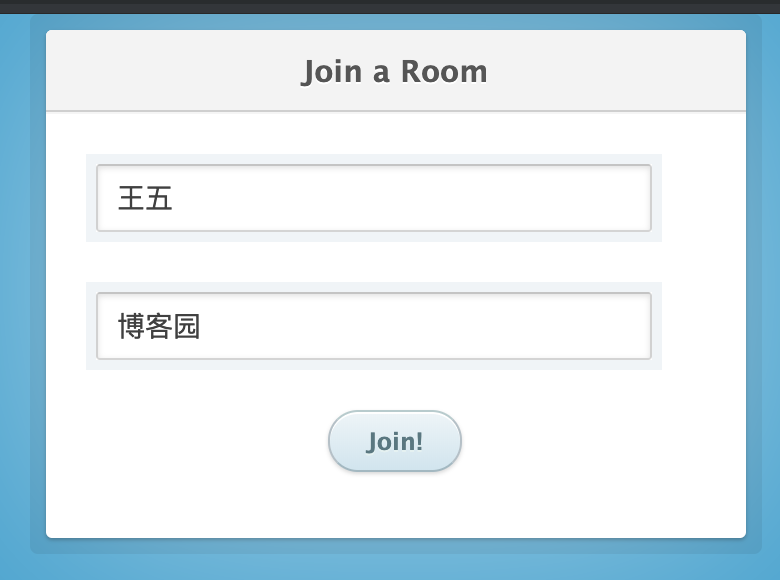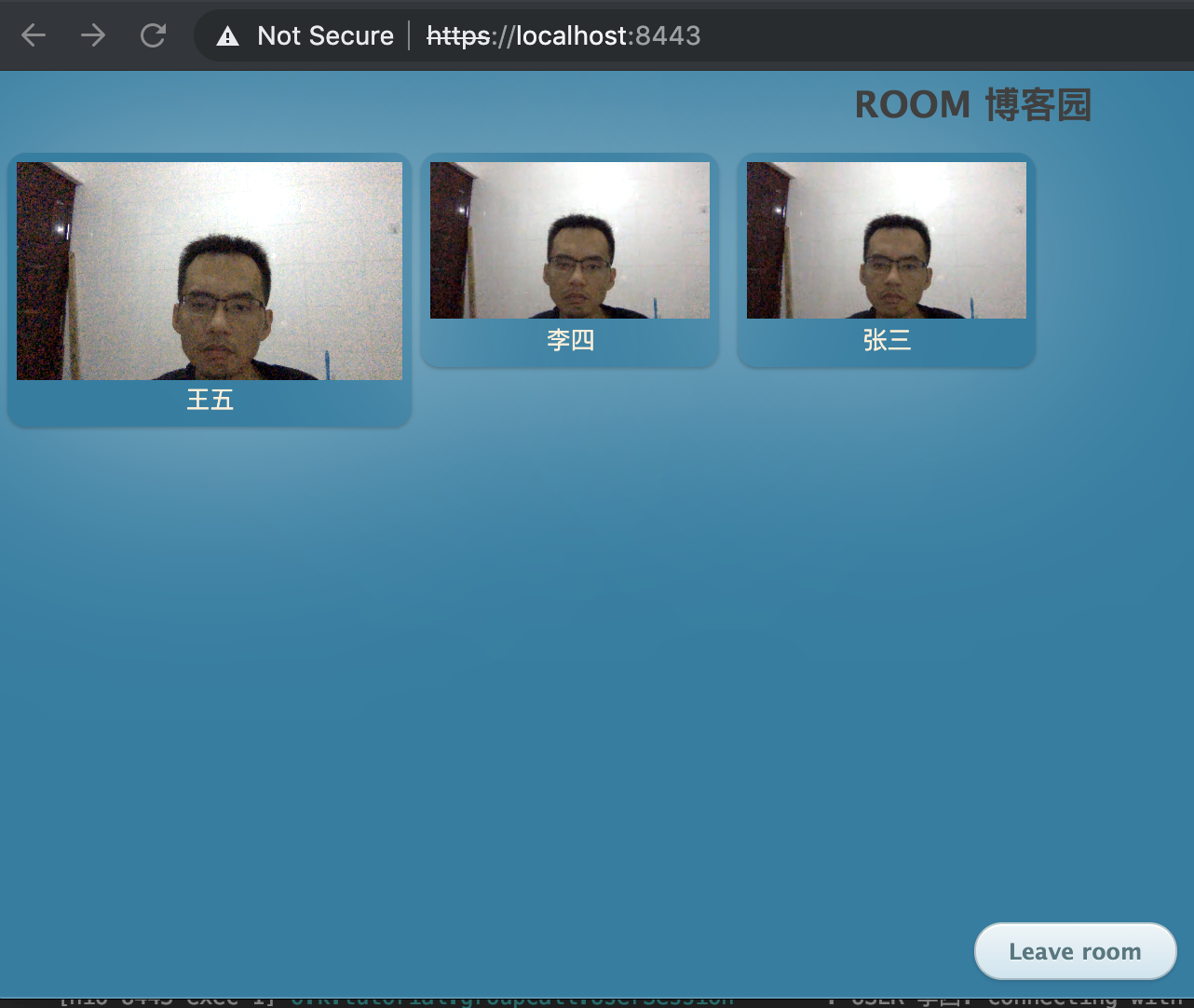这是kurento tutorial中的一个例子(groupCall),用于多人音视频通话,效果如下:
登录界面:

聊天界面:

运行方法:
2、idea里启用这个项目
3、浏览器里输入https://localhost:8443/ 输入用户名、房间号,然后再开一个浏览器tab页,输入一个不同的用户名,房间号与第1个tab相同,正常情况下,这2个tab页就能聊上了,还可以再加更多tab模拟多人视频(注:docker容器性能有限,mac本上实测,越过4个人,就很不稳定了)
下面是该项目的一些代码和逻辑分析:
一、主要模型的类图如下:

UserSession类:代表每个连接进来的用户会话信息。
Room类:即房间,1个房间可能有多个UserSession实例。
RoomManager类:房间管理,用于创建或销毁房间。
UserRegistry类:用户注册类,即管理用户。
二、主要代码逻辑:
1、创建房间入口
public Room getRoom(String roomName) {
log.debug("Searching for room {}", roomName);
Room room = rooms.get(roomName);
if (room == null) {
log.debug("Room {} not existent. Will create now!", roomName);
room = new Room(roomName, kurento.createMediaPipeline());
rooms.put(roomName, room);
}
log.debug("Room {} found!", roomName);
return room;
}
注:第7行,每个房间实例创建时,都绑定了一个对应的MediaPipeline(用于隔离不同房间的媒体信息等)
2、创建用户实例入口
public UserSession(final String name, String roomName, final WebSocketSession session,
MediaPipeline pipeline) {
this.pipeline = pipeline;
this.name = name;
this.session = session;
this.roomName = roomName;
this.outgoingMedia = new WebRtcEndpoint.Builder(pipeline).build();
this.outgoingMedia.addIceCandidateFoundListener(event -> {
JsonObject response = new JsonObject();
response.addProperty("id", "iceCandidate");
response.addProperty("name", name);
response.add("candidate", JsonUtils.toJsonObject(event.getCandidate()));
try {
synchronized (session) {
session.sendMessage(new TextMessage(response.toString()));
}
} catch (IOException e) {
log.debug(e.getMessage());
}
});
}
UserSession的构造函数上,把房间实例的pipeline做为入参传进来,然后上行传输的WebRtcEndPoint实例outgoingMedia又跟pipeline绑定(第8行)。这样:"用户实例--pipeline实例--房间实例" 就串起来了。
用户加入房间的代码:
public UserSession join(String userName, WebSocketSession session) throws IOException {
log.info("ROOM {}: adding participant {}", this.name, userName);
final UserSession participant = new UserSession(userName, this.name, session, this.pipeline);
//示例工程上,没考虑“相同用户名”的人进入同1个房间的情况,这里加上了“用户名重名”检测
if (participants.containsKey(userName)) {
final JsonObject jsonFailMsg = new JsonObject();
final JsonArray jsonFailArray = new JsonArray();
jsonFailArray.add(userName + " exist!");
jsonFailMsg.addProperty("id", "joinFail");
jsonFailMsg.add("data", jsonFailArray);
participant.sendMessage(jsonFailMsg);
participant.close();
return null;
}
joinRoom(participant);
participants.put(participant.getName(), participant);
sendParticipantNames(participant);
return participant;
}
原代码没考虑到用户名重名的问题,我加上了这段检测,倒数第2行代码,sendParticipantNames在加入成功后,给房间里的其它人发通知。
3、SDP交换的入口
kurento-group-call/src/main/resources/static/js/conferenceroom.js 中有一段监听websocket的代码:
ws.onmessage = function (message) {
let parsedMessage = JSON.parse(message.data);
console.info('Received message: ' + message.data);
switch (parsedMessage.id) {
case 'existingParticipants':
onExistingParticipants(parsedMessage);
break;
case 'newParticipantArrived':
onNewParticipant(parsedMessage);
break;
case 'participantLeft':
onParticipantLeft(parsedMessage);
break;
case 'receiveVideoAnswer':
receiveVideoResponse(parsedMessage);
break;
case 'iceCandidate':
participants[parsedMessage.name].rtcPeer.addIceCandidate(parsedMessage.candidate, function (error) {
if (error) {
console.error("Error adding candidate: " + error);
return;
}
});
break;
case 'joinFail':
alert(parsedMessage.data[0]);
window.location.reload();
break;
default:
console.error('Unrecognized message', parsedMessage);
}
}
服务端在刚才提到的sendParticipantNames后,会给js发送各种消息,existingParticipants(其它人加入)、newParticipantArrived(新人加入) 这二类消息,就会触发generateOffer,开始向服务端发送SDP
function onExistingParticipants(msg) {
const constraints = {
audio: true,
video: {
mandatory: {
maxWidth: 320,
maxFrameRate: 15,
minFrameRate: 15
}
}
};
console.log(name + " registered in room " + room);
let participant = new Participant(name);
participants[name] = participant;
let video = participant.getVideoElement();
const options = {
localVideo: video,
mediaConstraints: constraints,
onicecandidate: participant.onIceCandidate.bind(participant)
};
participant.rtcPeer = new kurentoUtils.WebRtcPeer.WebRtcPeerSendonly(options,
function (error) {
if (error) {
return console.error(error);
}
this.generateOffer(participant.offerToReceiveVideo.bind(participant));
});
msg.data.forEach(receiveVideo);
}
4、服务端回应各种websocket消息
org.kurento.tutorial.groupcall.CallHandler#handleTextMessage 信令处理的主要逻辑,就在这里:
@Override
public void handleTextMessage(WebSocketSession session, TextMessage message) throws Exception {
final JsonObject jsonMessage = gson.fromJson(message.getPayload(), JsonObject.class);
final UserSession user = registry.getBySession(session);
if (user != null) {
log.debug("Incoming message from user '{}': {}", user.getName(), jsonMessage);
} else {
log.debug("Incoming message from new user: {}", jsonMessage);
}
switch (jsonMessage.get("id").getAsString()) {
case "joinRoom":
joinRoom(jsonMessage, session);
break;
case "receiveVideoFrom":
final String senderName = jsonMessage.get("sender").getAsString();
final UserSession sender = registry.getByName(senderName);
final String sdpOffer = jsonMessage.get("sdpOffer").getAsString();
user.receiveVideoFrom(sender, sdpOffer);
break;
case "leaveRoom":
leaveRoom(user);
break;
case "onIceCandidate":
JsonObject candidate = jsonMessage.get("candidate").getAsJsonObject();
if (user != null) {
IceCandidate cand = new IceCandidate(candidate.get("candidate").getAsString(),
candidate.get("sdpMid").getAsString(), candidate.get("sdpMLineIndex").getAsInt());
user.addCandidate(cand, jsonMessage.get("name").getAsString());
}
break;
default:
break;
}
}
其中user.receiveVideoFrom方法,就会回应SDP
public void receiveVideoFrom(UserSession sender, String sdpOffer) throws IOException {
log.info("USER {}: connecting with {} in room {}", this.name, sender.getName(), this.roomName);
log.trace("USER {}: SdpOffer for {} is {}", this.name, sender.getName(), sdpOffer);
final String ipSdpAnswer = this.getEndpointForUser(sender).processOffer(sdpOffer);
final JsonObject scParams = new JsonObject();
scParams.addProperty("id", "receiveVideoAnswer");
scParams.addProperty("name", sender.getName());
scParams.addProperty("sdpAnswer", ipSdpAnswer);
log.trace("USER {}: SdpAnswer for {} is {}", this.name, sender.getName(), ipSdpAnswer);
this.sendMessage(scParams);
log.debug("gather candidates");
this.getEndpointForUser(sender).gatherCandidates();
}
SDP和ICE信息交换完成,就开始视频通讯了。
参考文章:
https://doc-kurento.readthedocs.io/en/6.10.0/tutorials/java/tutorial-groupcall.html